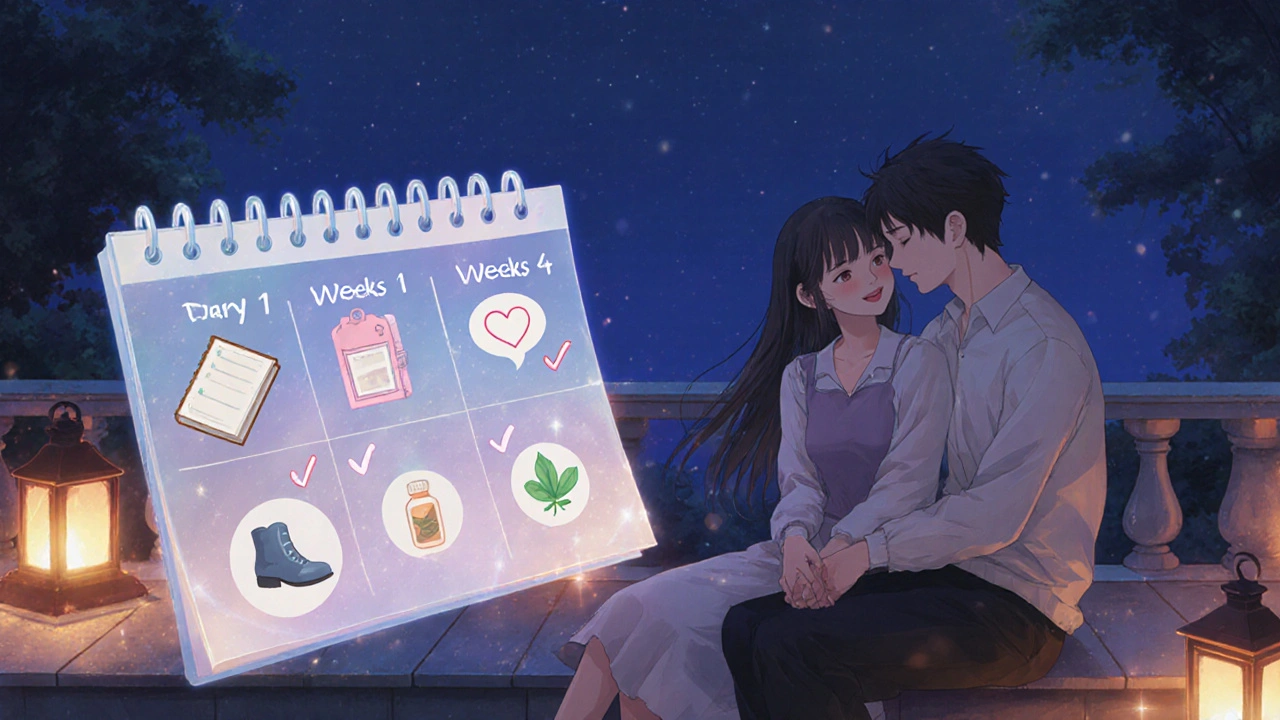Menopause Libido Treatment Selector
Personalized Approach
This tool helps you identify treatment options based on your specific symptoms, health history, and preferences. Results are not medical advice but can guide discussions with your healthcare provider.
Personalized Recommendations
Select your symptoms and preferences to see personalized recommendations.
When menopause hits, many women notice a shift in their sex drive. That dip can feel confusing, frustrating, or even embarrassing. The good news? You don’t have to accept it as a permanent change. Below are real‑world steps that help you understand why desire drops, what you can do about it, and how to keep intimacy alive.
Key Takeaways
- Hormonal swings, vaginal health, and emotional factors all play a role in decreased sexual desire during menopause.
- Medical options range from systemic hormone therapy to targeted vaginal estrogen.
- Non‑hormonal routes-like counseling, lifestyle tweaks, and certain herbal supplements-can boost libido without hormones.
- Open communication with a partner and a health‑care professional is the cornerstone of any plan.
What’s really happening? Understanding the drop in libido
Menopause is a natural biological transition marking the end of a woman's menstrual cycles, usually between ages 45 and 55. It signals a steep decline in estrogen and progesterone, hormones that influence mood, blood flow, and tissue elasticity. As these levels wane, many women experience decreased sexual desire a reduced interest in sexual activity, often reported alongside vaginal dryness and sleep disturbances. The shift isn’t just “in the mind”; it reflects measurable changes in the body’s chemistry.
While the hormonal picture gets most of the attention, three other layers matter just as much:
- Physical changes: Vaginal tissues thin, blood flow drops, and lubrication becomes scarce, making sex feel uncomfortable.
- Psychological factors: Mood swings, anxiety about aging, and body‑image concerns can mute desire.
- Relationship dynamics: Communication gaps or unresolved conflicts can turn intimacy into a chore.
How to pinpoint the cause
Start with a simple self‑audit. Keep a short journal for two weeks, noting when you feel interested, when you don’t, and any accompanying symptoms (sleep quality, mood, pain). Bring this to your GP or a menopause specialist. They’ll likely run a basic blood panel to check estradiol, testosterone, and thyroid levels. If the numbers look normal, the focus shifts to lifestyle and emotional health.
Medical routes: Hormone and non‑hormone therapies
There isn’t a one‑size‑fits‑all pill, but several evidence‑backed options exist. Below is a quick snapshot.
| Option | How it works | Typical effectiveness | Main risks | Best for |
|---|---|---|---|---|
| Systemic hormone therapy | Replaces estrogen (and sometimes progesterone) throughout the body | Improves desire in 60‑70% of users | Blood clots, breast tenderness, rare stroke | Women with moderate to severe vasomotor symptoms |
| Vaginal estrogen | Local application restores tissue thickness and lubrication | Boosts comfort, indirect benefit to desire | Minimal systemic absorption; rare irritation | Women primarily troubled by dryness |
| Testosterone therapy | Low‑dose transdermal patches or gels raise libido‑related hormones | Improves desire in 45‑55% of cases | Acne, voice deepening, lipid changes | Women without estrogen contraindications seeking a direct libido boost |
| Selective serotonin reuptake inhibitors (SSRIs) off‑label | Modulate serotonin to reduce anxiety and improve mood | Mixed; may help when low desire stems from mood | Nausea, weight gain, sexual side effects at higher doses | Women with concurrent depression or anxiety |
| Phytoestrogen‑rich herbs (e.g., red clover, black cohosh) | Plant compounds mimic weak estrogen activity | Modest benefit; evidence still emerging | Potential interaction with anticoagulants | Women preferring natural approaches |
Discussion with a clinician is essential. They’ll weigh your health history, personal preferences, and risk tolerance before suggesting a regimen.
Non‑pharmacological boosters
Even without meds, several habits can revive interest.
- Exercise: Regular aerobic and strength training raise endorphins and improve blood flow, which correlates with higher libido.
- Sleep hygiene: Aim for 7‑8 hours; poor sleep spikes cortisol, dampening desire.
- Mind‑body practices: Yoga, meditation, or tai chi ease stress, a common libido killer.
- Pelvic floor exercises: Strengthened muscles reduce discomfort and increase sensation.
- Nutrition: Foods rich in zinc (oysters, pumpkin seeds) and omega‑3s (salmon) support hormone production.

Communication: Partner involvement matters
Sexual health isn’t a solo project. Here’s a quick script to start the conversation:
- Pick a relaxed moment-not right after an argument or in the bedroom.
- Use “I” statements: “I’ve noticed my desire has changed, and I’d love us to explore how we can stay close.”
- Invite ideas: “What feels good for you right now? Anything new you’d like to try?”
- Agree on a trial period for any new approach (e.g., a month of weekly date nights).
If talking feels too hard, consider relationship counseling. A therapist can help both partners express needs without blame, turning the bedroom into a space of curiosity rather than pressure.
When to seek professional help
Visit a health‑care provider if any of these apply:
- Desire loss persists for more than six months and affects your mood.
- You experience pain, spotting, or unusual discharge.
- There’s a history of hormone‑sensitive cancers or blood‑clot disorders.
- Emotional distress (depression, anxiety) feels overwhelming.
A multidisciplinary team-GP, menopause specialist, pelvic floor physio, and therapist-offers the most holistic support.
Putting it all together: A 4‑week action plan
- Week 1 - Assess & Record: Start a desire journal and schedule a check‑up.
- Week 2 - Try a simple tweak: Add 30 minutes of brisk walking 4 times a week and a nightly 10‑minute mindfulness session.
- Week 3 - Discuss with your partner: Use the conversation script; plan one non‑sex intimate activity (massage, shared hobby).
- Week 4 - Review options: Based on lab results and personal preference, decide on a medical or herbal route, or continue lifestyle tweaks.
Reassess after the month. Most women notice a measurable lift in desire when at least two of the above pillars line up.
Can hormone therapy restore sex drive for everyone?
No. While many women report a boost, effectiveness varies based on individual hormone levels, age, and health history. Some may need a different approach, such as local estrogen or non‑hormonal options.
Are there safe over‑the‑counter supplements?
Phytoestrogen blends (red clover, black cohosh) are popular, but their potency is weak. Talk to a pharmacist before mixing them with prescription meds, especially blood thinners.
How long does it take to see results from vaginal estrogen?
Most women feel reduced dryness within 2‑4 weeks, and improved comfort can indirectly raise desire soon after.
Is testosterone therapy safe for women?
Low‑dose transdermal testosterone is approved in several countries for hypoactive sexual desire disorder. Monitoring lipid profiles and skin changes is recommended.
What role does mental health play?
A large share of libido changes stem from stress, anxiety, or depression. Addressing these with therapy or medication often lifts desire even without hormonal tweaks.
